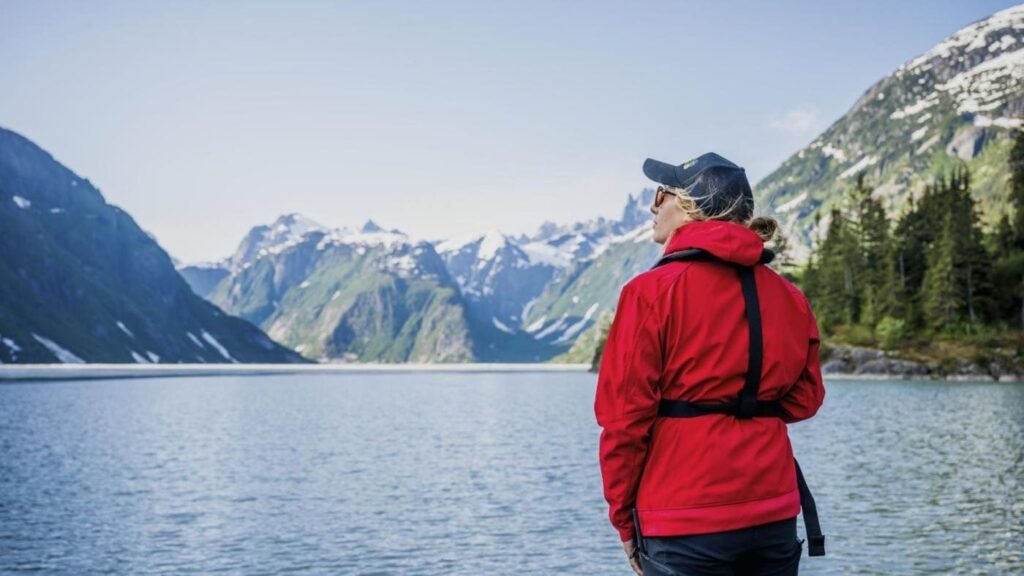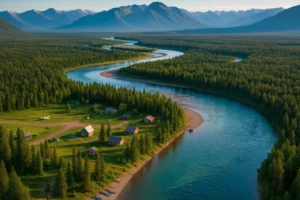Alaska travel companies contribute to the state’s economy through direct and indirect expenditures, job creation, and tax revenue generation.
The cruise industry, in particular, is a significant contributor, with Alaska ranking 5th in the cruise industry, generating $1.3 billion or 5.1% of the direct expenditures generated by the cruise industry in the United States.
Tourism-related businesses, such as tour operators, airlines, hotels, and travel agencies, receive a substantial portion of these expenditures, with approximately $807 million going to tourism-related businesses in Alaska.
Alaska Tourism Industry Economic Impact

The economic impact of tourism in Alaska is substantial, with the tourism industry contributing significantly to the state’s economy. In 2018, tourism businesses in Alaska created over $1.4 billion in payroll, resulting in an economic impact of $4.5 billion.
This industry plays a crucial role in Alaska, with one in ten jobs in the state related to tourism. Moreover, the tourism sector in Alaska is diverse, with more than half of all visitors arriving by cruise ship, highlighting the importance of the cruise industry in driving tourism-related economic activities in the state.
The Alaska Permanent Fund, established in 1976 and currently valued at approximately $64 billion, is funded by oil and mining revenues and has paid an average of around $1,600.
The fund issues yearly dividends to eligible Alaska residents, varying annually. Fueled by oil and mining revenues, this fund has become a significant economic contributor to the state, providing financial support to residents and contributing to economic stability in Alaska.
The Role of Alaska in the Nation’s Economy
Alaska plays a crucial role in the nation’s economy through different sectors, such as tourism, oil and gas, mining, and conservation lands.
1- Tourism:
The cruise industry is a big part of Alaska’s economy. It brought in $1.3 billion in 2019, which helped many businesses and created jobs. Even beyond direct spending, it supports local businesses and benefits residents.
2- Oil and Gas:
Oil and gas are significant players in Alaska’s economy. In 2022, these companies spent $4.6 billion on goods and services; their total tax and royalty payments were $4.5 billion. They also create jobs, support other industries, and help the state’s economy grow.
3- Mining:
Mining is growing in importance for Alaska. It provides jobs for many Alaskans and brings in millions of dollars in personal income. In 2022, it gave around 11,400 jobs, most going to residents.
4- Conservation Lands:
Alaska’s national parks and wilderness areas are not just beautiful; they also bring in money. They attract tourists, which supports local businesses and gives people jobs. Places like refuges in Alaska provided thousands of jobs and millions in income, with fishing being a big part of that.
What Economic Contributions Do Travel Companies Make in Alaska?
The travel companies in Alaska make substantial economic contributions through revenue generation, job creation, and support for local businesses. Their efforts not only bolster the state’s economy but also enhance the overall tourism experience for visitors, thereby fostering continued growth and prosperity within Alaska’s travel industry.
1- Contribution to Revenue Generation:
Alaska’s travel companies contribute substantially to the state’s revenue through tourism industries. The tourism sector, driven by travel companies, generates considerable revenue from domestic and international visitors. This revenue encompasses spending on accommodations, transportation, tours, and other related services, thereby stimulating economic growth.
2- Job Creation:
The operations of travel companies result in the creation of numerous job opportunities across various sectors. From tour guides and hospitality staff to transportation providers and administrative personnel, these companies support a diverse range of employment roles, thereby contributing to the livelihoods of many Alaskans and fostering economic stability within communities.
3- Support for Local Businesses:
Travel companies play a vital role in supporting local businesses within the state. By collaborating with local accommodations, restaurants, souvenir shops, and other enterprises, these companies help stimulate economic activity at the grassroots level. Additionally, partnerships with local suppliers and service providers further contribute to the sustainability and growth of small businesses throughout Alaska.
List of Travel Companies
- Alaska Outdoors
- Adventure Green Alaska (AGA) certified businesses
- G Adventures
- Trafalgar
- Infinite Adventures
- Globus
- BrushBuck Wildlife Tours
- National Geographic Expeditions
Economic Benefits of Travel Companies

1- Infrastructure Development:
These companies contribute to developing and maintaining tourism infrastructure, including roads, airports, and visitor centers, which benefit tourists and residents.
2- Cultural Preservation:
Through cultural tours, events, and educational programs, the companies help preserve and promote the state’s rich cultural heritage, ensuring the preservation of indigenous traditions and historical sites.
3- Technology Adoption:
Travel companies in Alaska often invest in advanced technologies, such as online booking systems and mobile apps, which streamline operations, enhance customer experiences, and improve efficiency.
4- Business Diversification:
Many travel companies engage in diverse business activities, such as eco-tourism, adventure travel, and wildlife safaris, which diversify the state’s economy and reduce dependence on a single industry.
5- International Trade:
Alaska’s travel companies facilitate international trade and commerce by attracting foreign tourists, fostering cultural exchange, and promoting Alaska-made products and goods.
6- Seasonal Employment:
The seasonal nature of tourism in Alaska provides employment opportunities for residents during peak tourist seasons, supplementing income and reducing unemployment rates in rural areas.
7- Educational Opportunities:
Alaska traveling companies often offer residents educational programs, internships, and training opportunities, providing valuable skills and knowledge for career advancement in the tourism industry.
8- Health and Wellness:
Travel companies promote health and wellness through outdoor activities, adventure sports, and wellness retreats, contributing to the overall well-being of tourists and residents.
9- Community Engagement:
These companies actively engage with local communities through charitable initiatives, sponsorships, and volunteer programs, fostering a sense of community pride and social responsibility.
10- Destination Marketing:
Travel companies play a crucial role in marketing Alaska as a premier tourist destination through advertising campaigns, promotional events, and participation in travel expos, attracting visitors worldwide and boosting tourism revenues.
Support For Local Businesses by Alaska Tourism Companies
– BuyAlaska Local First Campaign:
Alaska’s tourism companies actively support local businesses through initiatives like the BuyAlaska Local First campaign. This campaign connects consumers with Alaska-based companies, urging them to prioritize spending within the local economy.
– Growth Catalyst:
Tourism catalyzes the growth of new businesses and increases tax contributions, particularly in southeast Alaska communities experiencing higher visitor volumes. Towns like Haines, Craig, and Hoonah showcase how tourism fuels business growth, alters social dynamics, and boosts tax revenues.
– Expansion Impact:
Increased tourist activity in remote areas leads to subsistence harvest patterns and local recreation use shifts. The expansion of tourism enriches local economies, encouraging diversification beyond traditional revenue streams.
– Shopping Local Advocacy:
The Alaska Small Business Development Center’s online directory facilitates easy access to authentic Alaskan products, promoting local shopping and supporting small businesses. By choosing local tour vendors in destinations like Skagway, tourists directly contribute to the sustainability of Alaska’s regional economies.
– Creating Sustainable Communities:
Alaska tourism companies are pivotal in nurturing vibrant and sustainable local economies, benefiting residents and visitors. Their support for local businesses ensures economic resilience and fosters community prosperity in Alaska’s diverse regions.
Alaska Tourism Sector’s Role in Protecting the Environment
- The Adventure Green Alaska (AGA) program certifies sustainable tourism businesses in Alaska, encouraging travelers to support eco-friendly practices.
- AGA program supports local businesses and communities and the preservation of Alaska’s natural environment, history, and culture.
- Tourism companies like Spirit Walker Expeditions prioritize environmental conservation by maintaining bear-safe camps and minimizing their impact on trips.
- Alaska’s wilderness areas, comprising 38% of the state’s land, are significant attractions for visitors who value their wilderness character.
- Balancing economic growth and environmental protection poses challenges for the tourism industry, particularly evident in the ecological impact of the cruise industry.
- Small ship cruises are a more sustainable alternative to large cruise ships, offering a greener option for tourists exploring Alaska’s pristine landscapes.
Final Verdict
Alaska travel companies play a vital role in the state’s economy. The cruise industry alone generated $1.3 billion in 2019, benefiting local businesses. Tourism overall created over $1.4 billion in payroll, supporting one in ten jobs statewide. Programs like Adventure Green Alaska promote sustainability, ensuring economic, environmental, and cultural balance. Companies like Spirit Walker Expeditions prioritize conservation. Small ship cruises offer eco-friendly options. Despite challenges, Alaska’s tourism sector remains committed to sustainability for long-term prosperity.
FAQs
How much money does Alaska make from tourism?
2022-23, tourism contributed $5.6 billion to Alaska’s economy. It directly employed over 43,000 people in 2022. Tourism also brought in $157 million in revenue for the State of Alaska in 2023
What industry makes the most money in Alaska?
The oil and gas industry
How does tourism benefit Alaska?
Tourism benefits Alaska by providing jobs, revenue, and economic impact, with spending distributed widely throughout the state’s economy.
What is the best time to visit Alaska?
The best time to visit Alaska is during the summer, from May to September when the weather is mild and the days are long.
What is the cheapest month to visit Alaska?
The cheapest month to visit Alaska is typically in the off-season, from October to April when airfare and accommodation prices are lower.
Is Alaska an expensive place to visit?
Yes, Alaska can be expensive, with high accommodation, food, and transportation costs.
Is it expensive to live in Alaska?
Yes, living in Alaska can also be expensive, with high housing, food, and transportation costs. However, it offers a high standard of living with low taxes and abundant natural resources.











